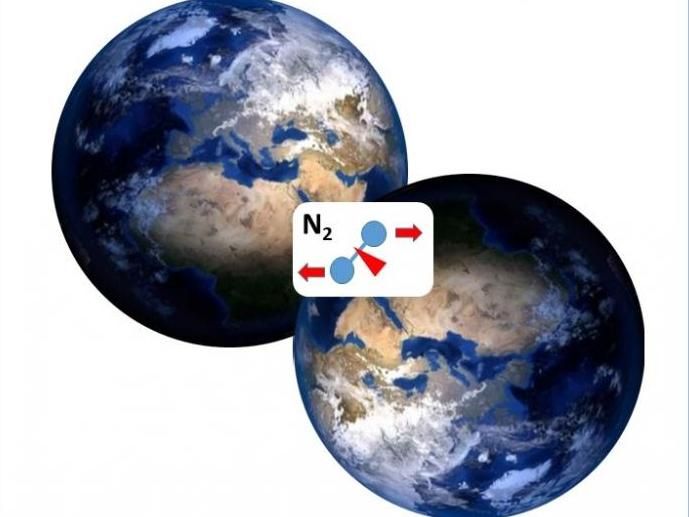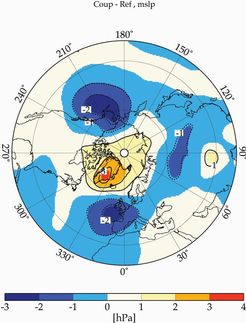Intense conditions turn nitrogen metallic
Advertisement
New work from a team led by Carnegie's Alexander Goncharov confirms that nitrogen, the dominant gas in Earth's atmosphere, becomes a metallic fluid when subjected to the extreme pressure and temperature conditions found deep inside the Earth and other planets.

Nitrogen is the dominant gas in Earth's atmosphere, where it is most-commonly bonded with itself in diatomic N2 molecules. New work indicate that it becomes a metallic fluid when subjected to the extreme pressure and temperature conditions found deep inside the Earth and other planets.
Illustration courtesy of Alexander Goncharov.
Nitrogen is one of the most-common elements in the universe and is crucial to life on Earth. In living organisms, it is a key part of the makeup of both the nucleic acids that form genetic material and the amino acids that make up proteins. It comprises nearly 80 percent of the Earth's atmosphere.
But what about how nitrogen behaves in the intense pressure and high temperatures found inside a planet?
"Nitrogen could get into the Earth's mantle when one tectonic plate slides beneath another--a process called subduction--and could even make its way into the iron-rich core as an impurity," explained Carnegie's Shuqing Jiang, the paper's lead author, "or it could be a remnant from Earth's formation that didn't escape via volcanic activity to form the proto-atmosphere in Earth's babyhood."
In Earth's atmosphere, nitrogen is most-commonly bonded with itself in so-called diatomic, N2, molecules. Calculations indicate that at extreme pressures and temperatures, such as those found deep inside Earth, nitrogen should transform from an insulating--or non-electrically conductive--diatomic molecule to a metallic--or electrically conductive--fluid polymer, comprised of atoms linked by complex molecular bonds.
Previous experiments showed evidence of diatomic nitrogen molecules disassociating and changing states under extreme pressures and temperatures, but a greater range of conditions needed to be explored.
Goncharov and the team--which also includeded Carnegie's Fuhai Su, University of Chicago's Nicholas Holtgrewe, GFZ German Research Centre for Geosciences' Sergey Lobanov, Howard University's Mohammad Mahmood, and University of Edinburgh's Stewart McWilliams--set out to further probe these extreme-condition transitions using the geophysicist's best friend, a laser-heated diamond anvil cell.
They found that the temperature at which nitrogen transitions from insulating to metallic decreases as the pressure increases--starting at about 1,180,000 times normal atmospheric pressure (120 gigapascals) and 2,720 degrees Celsius (3,000 kelvin).
"This means that, theoretically, nitrogen would remain in its diatomic state in the Earth's mantle but would disassociate into a fluid metal in or just above the core, which potentially has implications for our understanding of the planet's deep nitrogen cycle," said Lobanov, who was at Stony Brook University when the research was conducted.
Added Holtgrewe: "Our findings could inform the efforts to create forms of energetic nitrogen polymers as well as superconducting, metallic states of a sister diatomic molecule, hydrogen or H2, which could revolutionize the energy sector if reliably synthesized."
Original publication
Shuqing Jiang, Nicholas Holtgrewe, Sergey S. Lobanov, Fuhai Su, Mohammad F. Mahmood, R. Stewart McWilliams & Alexander F. Goncharov; "Metallization and molecular dissociation of dense fluid nitrogen"; Nature Comm.; 2018
























































